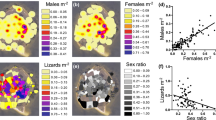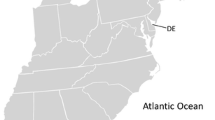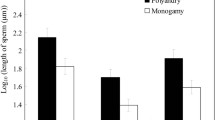Abstract
Many species differ genetically, physiologically, and morphologically between geographically distinct populations, typically in response to variation in ecological and climatic variables. Little is known, however, about geographical variation in sperm morphology. Sperm morphology is under strong sexual selection, has been shown to evolve rapidly, and often co-varies with other reproductive traits (e.g., testis size or mating system) that differ between populations in some species. The aim of this study was to establish whether sperm morphology varies between populations of the red-winged blackbird (Agelaius phoeniceus), a species with an enormous breeding range and marked inter-population variation in both body size and mating system. We found (1) highly significant variation in sperm morphology among study sites, (2) a gradual increase in sperm length from the southwest to the northeast of the breeding range, and (3) a strong negative association between sperm length and body size. However, the relationship with the mating system remains unclear. Several hypotheses to explain these patterns are proposed.





Similar content being viewed by others
References
Allen JP, Hamon JH, McFarlane RW (1967) Some studies of the spermatozoa of certain species of the Icteridae (Blackbirds). Proc Indiana Acad Sci 77:434–441
Atkinson D, Sibly RM (1997) Why are organisms usually bigger in colder environments? Making sense of a life history puzzle. Trends Ecol Evol 12:235–239
Ball RM Jr, Freeman S, James FC, Bermingham E, Avise JC (1988) Phylogeographic population structure of red-winged blackbirds assessed by mitochondrial DNA. Proc Natl Acad Sci USA 85:1558–1562
Balshine S, Leach BJ, Neat F, Werner NY, Montgomerie R (2001) Sperm size of African cichlids in relation to sperm competition. Behav Ecol 12:726–731
Banerjee S, Carlin BP, Gelfand AE (2004) Hierarchical modeling and analysis for spatial data. Chapman & Hall/CRC, Boca Raton
Beletsky L (1996) The red-winged blackbird. The biology of a strongly polygynous songbird. Academic Press, London
Bergmann C (1847) Über die Verhältnisse der Wärmeökonomie der Thiere zu ihrer Grösse. Göttinger Studien 1:595–708
Birkhead TR, Biggins JD (1987) Reproductive synchrony and extra-pair copulation in birds. Ethology 74:320–334
Birkhead TR, Martínez JG, Burke T, Froman DP (1999) Sperm mobility determines the outcome of sperm competition in the domestic fowl. Proc R Soc Lond B 266:1759–1764
Birkhead TR, Pellatt EJ, Brekke P, Yeates R, Castillo-Juarez H (2005) Genetic effects on sperm design in the zebra finch. Nature 434:383–387
Björklund M (1991) Evolution, phylogeny, sexual dimorphism and mating system in the grackles (Quiscalus spp.: Icterinae). Evolution 45:608–621
Blake (1968) Family Icteridae. In: Paynter RA Jr (ed) Check-list of birds of the world, vol XIV. Museum of Comparative Zoology, Harvard University, Cambridge, pp 138–202
Blanckenhorn WU, Demont M (2004) Bergmann and converse Bergmann latitudinal clines in arthropods: two ends of a continuum? Integr Comp Biol 44:413–424
Blanckenhorn WU, Hellriegel B (2002) Against Bergmann’s rule: fly sperm size increases with temperature. Ecol Lett 5:7–10
Briskie JV, Montgomerie R (1992) Sperm size and sperm competition in birds. Proc R Soc Lond B 247:89–95
Briskie JV, Montgomerie R, Birkhead TR (1997) The evolution of sperm size in birds. Evolution 51:937–945
Burrows WH, Quinn JP (1937) The collection of spermatozoa from domestic fowl and turkey. Poult Sci 16:19–24
Byrne PG, Simmons LW, Roberts JD (2003) Sperm competition and the evolution of gamete morphology in frogs. Proc R Soc Lond B 270:2079–2086
Calhim S, Birkhead TR (2007) Testes size in birds: quality versus quantity—assumptions, errors, and estimates. Behav Ecol 18:271–275
Calhim S, Immler S, Birkhead TR (2007) Postcopulatory sexual selection is associated with reduced variation in sperm morphology. PLoS ONE 2:e413. doi:10.1371/journal.pone.0000413
Cornwallis CK, Birkhead TR (2007) Changes in sperm quality and numbers in response to experimental manipulation of male social status and female attractiveness. Am Nat 170:758–770
Cummins JM, Woodall PF (1985) On mammalian sperm dimensions. J Reprod Fertil 75:153–175
Dolbeer WA (1978) Movement and migration patterns of red-winged blackbirds: a continental overview. Bird Band 49:17–34
Dziminski MA, Roberts JD, Beveridge M, Simmons LW (2010) Among-population covariation between sperm competition and ejaculate expenditure in frogs. Behav Ecol 21:322–328
Elgee KE, Evans JP, Ramnarine IW, Rush SA, Pitcher TE (2010) Geographic variation in sperm traits reflects predation risk and natural rates of multiple paternity in the guppy. J Evol Biol 23:1331–1338
Emlen ST, Oring LW (1977) Ecology, sexual selection, and evolution of mating systems. Science 197:215–223
Emslie SD (1998) Avian community, climate, and sea-level changes in the Plio-Pleistocene of the Florida Peninsula. Ornithol Monogr 50:1–113
Endler JA (1977) Geographic variation, speciation, and clines. Princeton University Press, Princeton
Fitzpatrick JL, Montgomerie R, Desjardins JK, Stiver KA, Kolm N, Balshine S (2009) Female promiscuity promotes the evolution of faster sperm in cichlid fishes. Proc Natl Acad Sci USA 106:1128–1132
Gage MJG (1994) Associations between body size, mating pattern, testis size and sperm lengths across butterflies. Proc R Soc Lond B 258:247–254
Garrido O, Kirkconnell A (1996) Taxonomic status of the Cuban form of the red-winged blackbird. Wilson Bull 108:372–374
Gavin TA, Howard RA, May B (1991) Allozyme variation among breeding populations of red-winged blackbirds: the California conundrum. Auk 108:602–611
Gibbs HL, Weatherhead PJ, Boag PT, White BN, Tabak LM, Hoysak DJ (1990) Realized reproductive success of polygynous red-winged blackbirds revealed by DNA markers. Science 250:1394–1397
Gomendio M, Roldan ERS (2008) Implications of diversity in sperm size and function for sperm competition and fertility. Int J Dev Biol 52:439–447
Gould SJ, Johnston RF (1972) Geographic variation. Annu Rev Ecol Syst 3:457–498
Gray EM (1996) Female control of offspring paternity in a western population of red-winged blackbirds (Agelaius phoeniceus). Behav Ecol Sociobiol 38:267–278
Gray EM (1997a) Do female red-winged blackbirds benefit genetically from seeking extra-pair copulations? Anim Behav 53:605–623
Gray EM (1997b) Intraspecific variation in extra-pair behavior of red-winged blackbirds (Agelaius phoeniceus). Ornithol Monogr 49:61–80
Hettyey A, Roberts JD (2006) Sperm traits of the quacking frog, Crinia georgiana: intra- and interpopulation variation in a species with a high risk of sperm competition. Behav Ecol Sociobiol 59:389–396
Hill GE (1994) Geographic variation in male ornamentation and female mate preference in the house finch: a comparative test of models of sexual selection. Behav Ecol 5:64–73
Holwell GI (2008) Geographic variation in genital morphology of Ciulfina praying mantids. J Zool 276:108–114
Hosken DJ, Garner TWJ, Blanckenhorn WU (2003) Asymmetry, testis and sperm size in yellow dung flies. Funct Ecol 17:231–236
Howell AH, van Rossem AJ (1928) A study of the red-winged blackbirds of souteasthern United States. Auk 45:155–163
Huey RB, Gilchrist GW, Carlson ML, Berrigan D, Serra L (2000) Rapid evolution of a geographic cline in size in an introduced fly. Science 287:308–309
Immler S, Birkhead TR (2005) A non-invasive method for obtaining spermatozoa from birds. Ibis 147:827–830
James FC (1970) Geographic variation in birds and its relationship to climate. Ecology 51:3
James FC (1983) Environmental component of morphological differentiation in birds. Science 221:184–186
Jaramillo A, Burke P (1999) New World blackbirds: the icterids. Helm, London
Kiefer MC, Van Sluys M, Rocha CFD (2008) Clutch and egg size of the tropical lizard Tropidurus torquatus (Tropiduridae) along its geographic range in coastal eastern Brazil. Can J Zool 86:1376–1388
Kleven O, Fossøy F, Laskemoen T, Robertson RJ, Rudolfsen G, Lifjeld JT (2009) Comparative evidence for the evolution of sperm swimming speed by sperm competition and female sperm storage duration in passerine birds. Evolution 63:2466–2473
Klicka J, Zink RM (1997) The importance of recent ice ages in speciation: a failed paradigm. Science 277:1666–1668
Kuramoto M (1996) Generic differentiation of sperm morphology in treefrogs from Japan and Taiwan. J Herpetol 30:437–443
Lack D (1947) Significance of clutch-size, parts I and II. Ibis 89:302–552
Legendre P (2000) Comparison of permutation methods for the partial correlation and partial Mantel tests. J Stat Comput Simul 67:37–73
Legendre P, Fortin M-J (1989) Spatial pattern and ecological analysis. Vegetatio 80:107–138
Lüpold S, Calhim S, Immler S, Birkhead TR (2009a) Sperm morphology and sperm velocity in passerine birds. Proc R Soc Lond B 276:1175–1181
Lüpold S, Linz GM, Birkhead TR (2009b) Sperm design and variation in the New World blackbirds (Icteridae). Behav Ecol Sociobiol 63:899–909
Lüpold S, Linz GM, Rivers JW, Westneat DF, Birkhead TR (2009c) Sperm competition selects beyond relative testes size in birds. Evolution 63:391–402
Macedo RH, Karubian J, Webster MS (2008) Extrapair paternity and sexual selection in socially monogamous birds: are tropical birds different? Auk 125:769–777
Manier MK, Palumbi SR (2008) Intraspecific divergence in sperm morphology of the green sea urchin, Strongylocentrotus droebachiensis: implications for selection in broadcast spawners. BMC Evol Biol 8:283. doi:10.1186/1471-2148-8-283
Mantel N (1967) The detection of disease clustering and a generalized regression approach. Cancer Res 27:209–220
Mayr E (1963) Animal species and evolution. Harvard University Press, Cambridge
McFarlane RW (1963) The taxonomic significance of avian sperm. Proc XIII Int Ornithol Congr 91:91–102
Miller GT, Pitnick S (2002) Sperm-female coevolution in Drosophila. Science 298:1230–1233
Minoretti N, Baur B (2006) Among- and within-population variation in sperm quality in the simultaneously hermaphroditic land snail Arianta arbustorum. Behav Ecol Sociobiol 60:270–280
Møller AP (1995) Sexual selection in the barn swallow (Hirundo rustica). V. Geographic variation in ornament size. J Evol Biol 8:3–19
Moore WS, Dolbeer WA (1989) The use of banding recovery data to estimate dispersal rates and gene flow in avian species: case studies in the red-winged blackbird and common grackle. Condor 91:242–253
Moran PAP (1950) Notes on continuous stochastic phenomena. Biometrika 37:17–23
Morrow EH, Gage MJG (2001a) Artificial selection and heritability of sperm length in Gryllus bimaculatus. Heredity 87:356–362
Morrow EH, Gage MJG (2001b) Consistent significant variation between individual males in spermatozoal morphometry. J Zool 254:147–153
Mossman J, Slate J, Humphries S, Birkhead TR (2009) Sperm morphology and velocity are genetically co-determined in the zebra finch. Evolution 63:2730–2737
Murton RK, Westwood NJ (1977) Avian breeding cycles. Clarendon Press, Oxford
Orians GH (1980) Some adaptations of marsh-nesting blackbirds. Princeton University Press, Princeton
Parapanov R, Nusslé S, Hausser J, Vogel P (2008) Relationships of basal metabolic rate, relative testis size and cycle length of spermatogenesis in shrews (Mammalia, Soricidae). Reprod Fertil Dev 20:431–439
Parker GA (1990) Sperm competition games: sneaks and extra-pair copulations. Proc R Soc Lond B 242:127–133
Parker GA (1993) Sperm competition games: sperm size and sperm number under adult control. Proc R Soc Lond B 253:245–254
Parker GA, Immler S, Pitnick S, Birkhead TR (2010) Sperm competition games: sperm size (mass) and number under raffle and displacement, and the evolution of P2. J Theor Biol 264:1003–1023
Pellatt EJ, Birkhead TR (1994) Ejaculate size in zebra finches Taeniopygia guttata and a method for obtaining ejaculates from passerine birds. Ibis 136:97–106
Pitcher TE, Stutchbury BJM (1998) Latitudinal variation in testis size in six species of North American songbirds. Can J Zool 76:618–622
Pitnick S, Miller GT, Schneider K, Markow TA (2003) Ejaculate-female coevolution in Drosophila mojavensis. Proc R Soc Lond B 270:1507–1512
Pitnick S, Hosken DJ, Birkhead TR (2009) Sperm morphological diversity. In: Birkhead TR, Hosken DJ, Pitnick S (eds) Sperm biology: an evolutionary perspective. Elsevier, London, pp 69–149
Pizzari T, Cornwallis CK, Froman D (2007) Social competitiveness associated with rapid fluctuations in sperm quality in male fowl. Proc R Soc Lond B 274:853–860
Podos J, Warren PS (2007) The evolution of geographic variation in birdsong. Adv Study Behav 37:403–458
Power DM (1969) Evolutionary implications of wing and size variation in the red-winged blackbird in relation to geographic and climatic factors: a multiple regression analysis. Syst Zool 18:363–373
Power DM (1970) Geographic variation of red-winged blackbirds in Central North America. Univ Kansas Publ Mus Nat Hist 19:1–83
Prather JW, Cruz A (2006) Breeding biology of red-winged blackbirds in South Florida. Southeast Nat 5:547–554
Prevosti A, Serra L, Segarra E, Aguadé M, Ribó G, Monclús M (1990) Clines of chromosomal arrangements of Drosophila subobscura in South America evolve closer to old world patterns. Evolution 44:218–221
Ramm SA, Stockley P (2010) Sperm competition and sperm length influence the rate of mammalian spermatogenesis. Biol Lett 6:219–221
Rezende EL, Swanson DL, Fernando Novoa F, Bozinovic F (2002) Passerines versus nonpasserines: so far, no statistical differences in the scaling of avian energetics. J Exp Biol 205:101–107
Roff DA (1992) The evolution of life histories: theory and analysis. Chapman & Hall, New York
Rosenberg MS (2001) PASSaGE. Pattern analysis, spatial statistics, and geographic exegesis. www.passagesoftware.net, Tempe, Arizona
Samour JH, Smith CA, Moore HD, Markham JA (1986) Semen collection and spermatozoa characteristics in budgerigars (Melopsittacus undulatus). Vet Rec 118:397–399
Searcy WA, Yasukawa K (1995) Polygyny and sexual selection in red-winged blackbirds. Princeton University Press, Princeton
Short RV (1981) Sexual selection in man and the great apes. In: Graham CE (ed) Reproductive biology of the great apes. Academic Press, New York, pp 319–341
Simon G (1997) An angular version of spatial correlations, with exact significance tests. Geogr Anal 29:267–278
Snook RR (2001) Absence of latitudinal clines in sperm characters in North American populations of Drosophila subobscura (Diptera: Drosophilidae). Pan-Pac Entomol 77:261–271
Spottiswoode C, Møller AP (2004) Extrapair paternity, migration, and breeding synchrony in birds. Behav Ecol 15:41–57
Stearns SC (1992) The evolution of life histories. Oxford University Press, Oxford
Stutchbury BJ, Morton ES (1995) The effect of breeding synchrony on extra-pair mating systems in songbirds. Behaviour 132:675–690
Van Rossem AJ (1926) The California forms of Agelaius phoeniceus (Linnaeus). Condor 28:215–230
Weatherhead PJ (1979) Ecological correlates of monogamy in tundra-breeding savannah sparrows. Auk 96:391–401
Weatherhead PJ (1995) Effects on female reproductive success of familiarity and experience among male red-winged blackbirds. Anim Behav 49:967–976
Weatherhead PJ, Boag PT (1995) Pair and extra-pair mating success relative to male quality in red-winged blackbirds. Behav Ecol Sociobiol 37:81–91
Webster MS (1992) Sexual dimorphism, mating system and body size in New World blackbirds (Icterinae). Evolution 46:1621–1641
Westneat DF (1993a) Polygyny and extrapair fertilizations in eastern red-winged blackbirds (Agelaius phoeniceus). Behav Ecol 4:49–60
Westneat DF (1993b) Temporal patterns of within-pair copulations, male mate guarding, and extra-pair events in eastern red-winged blackbirds (Agelaius phoeniceus). Behaviour 124:267–290
Westneat DF (2006) No evidence of current sexual selection on sexually dimorphic traits in a bird with high variance in mating success. Am Nat 167:E171–E189
Westneat DF, Mays HL (2005) Tests of spatial and temporal factors influencing extra-pair paternity in red-winged blackbirds. Mol Ecol 14:2155–2167
Westneat DF, Sherman PW (1997) Density and extra-pair fertilizations in birds: a comparative analysis. Behav Ecol Sociobiol 41:205–215
Westneat DF, McGraw LA, Fraterrigo JM, Birkhead TR, Fletcher F (1998) Patterns of courtship behavior and ejaculate characteristics in male red-winged blackbirds. Behav Ecol Sociobiol 43:161–171
Williams CL, Homan HJ, Johnston JJ, Linz GM (2004) Microsatellite variation in red-winged blackbirds (Agelaius phoeniceus). Biochem Genet 42:35–41
Woolley DM (1971) Selection for the length of the spermatozoan midpiece in the mouse. Genet Res 16:261–275
Wright PL, Wright MH (1944) Reproductive cycle of the male red-winged blackbird. Condor 46:46–59
Acknowledgments
We thank J. Homan, G. Linz, L. Reinhardt, A. Trutsch, and K. Yasukawa for their help in the field, R. Byrd, J. Cummins, D. Elwonger, L. Merrill, T. Muir, J. Rivers, V. Rohwer, S. Tupper, S. Werner, and M. Whitfield for providing additional sperm samples, the SPU meeting at Syracuse University for insightful discussion, and R. Montgomerie, R. Snook and three anonymous reviewers for valuable comments on the manuscript. S.L. was supported by the Janggen-Poehn Foundation, Swiss National Science Foundation, a Sheffield University ORS Award, a Lauff Research Award, a KBS Visiting Graduate Student Fellowship, and an NSF LTER Graduate Research Award; D.F.W. by the University of Kentucky; and T.R.B. by the Leverhulme Trust.
Author information
Authors and Affiliations
Corresponding author
Electronic supplementary material
Below is the link to the electronic supplementary material.
Rights and permissions
About this article
Cite this article
Lüpold, S., Westneat, D.F. & Birkhead, T.R. Geographical variation in sperm morphology in the red-winged blackbird (Agelaius phoeniceus). Evol Ecol 25, 373–390 (2011). https://doi.org/10.1007/s10682-010-9410-5
Received:
Accepted:
Published:
Issue Date:
DOI: https://doi.org/10.1007/s10682-010-9410-5




